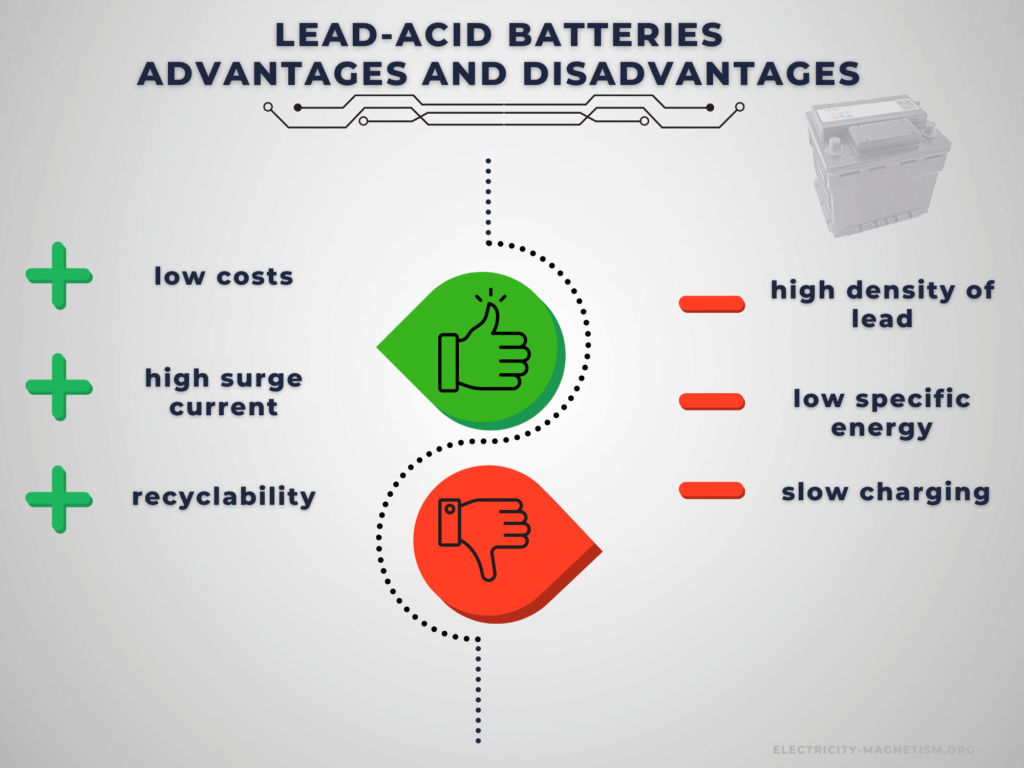Lead-acid batteries is one of the oldest technologies used in motor vehicles and energy storage systems. It offers a number of advantages, such as low cost and reliability. However, it also has its drawbacks, notably its low storage capacity and negative environmental impact. In this article, we take a closer look at benefits and disadvantages of the lead-acid battery.
Production of lead battery plates and restoration of a flat battery
[arve url="https://www.youtube.com/embed/PdMWBv8kAo0″/]
What are the advantages of lead batteries?
Lead batteries offer several advantages:
1. Ease of use : Lead batteries are easy to handle and install, making them accessible to all users, whether professional or amateur.
2. Affordable cost : Lead-acid batteries are generally less expensive than other types, making them a more economical option for many users.
3. Reliability : Lead batteries are renowned for their reliability. They offer consistent performance over a long period of time, making them the preferred choice in many sectors.
4. Durability : Lead-acid batteries are renowned for their relatively long service life. If properly maintained, they can last for many years, making them a worthwhile long-term investment.
5. Resistance to extreme temperatures : Lead-acid batteries are capable of operating under extreme temperature conditions, making them ideal for use in harsh environments.
6. Fast charging capability : Lead-acid batteries are fast-charging, which means they can be recharged quickly when needed.
However, it should be noted that lead-acid batteries also have some disadvantages, such as high weight, low energy density and adverse effects on the environment due to their chemical composition.
How long does a lead-acid battery last?
The service life of a lead-acid battery depends on a number of factors, such as its quality, use and the conditions in which it is stored. In general, a lead-acid battery will last between 3 and 5 years.
However, it is important to note that intensive or incorrect use of the battery can considerably reduce its lifespan. For example, if the battery is regularly undercharged or overcharged, this can damage its internal components and shorten its lifespan.
We therefore recommend that you follow the manufacturer's instructions for battery use and maintenance, to optimize battery life. This can include tips such as not letting the battery discharge completely, recharging it regularly and checking its electrolyte level regularly.
Finally, it's important to bear in mind that lead-acid batteries have a limited recharging capacity, which means they will gradually lose their efficiency over time. It is therefore advisable to replace the battery after a few years, to ensure optimal operation of the equipment powered by it.
In conclusion, the service life of a lead-acid battery generally varies between 3 and 5 years, but this can be influenced by a number of factors. It's essential to follow the manufacturer's advice to prolong the battery's lifespan and ensure its proper functioning.
How do I maintain a lead-acid battery?
Maintaining a lead-acid battery is essential to prolonging its life and ensuring its proper functioning. Here are some important tips to follow:
1. Keep it charged : A lead-acid battery needs to be kept charged to prevent complete discharge, which can damage the internal plates. Use a suitable charger to maintain the battery at an optimum level.
2. Check electrolyte level regularly : Lead-acid batteries require distilled water to maintain the electrolyte level between the minimum and maximum marks. Check the level regularly and add distilled water if necessary.
3. Clean terminals : Battery terminals can accumulate corrosion and cause weak connections. Use a wire brush or specialized cleaner to clean terminals and cables regularly.
4. Check connections : Make sure all battery connections are tight and clean. Loose or corroded connections can lead to charging and starting problems.
5. Avoid extreme temperatures : Lead-acid batteries can be sensitive to extreme temperatures, especially frost. If possible, keep the battery in a place where the temperature remains constant.
6. Take care when storing : If you're not going to be using the battery for a long time, make sure you store it in a cool, dry place, away from vibrations and shocks.
By following these tips, you can extend the life of your lead-acid battery and optimize its performance.
When to recharge a lead-acid battery?
When to recharge a lead-acid battery?
When it comes to recharging a lead-acid battery, there are several important factors to consider. Here are some of the key times when it's advisable to recharge such a battery:
1. Full discharge : When the lead-acid battery is completely discharged, it's time to recharge. This can happen when you use the battery-powered device until it switches off, or when you measure a low voltage on the battery.
2. Regular maintenance : To prevent battery degradation and maintain optimum performance, we recommend recharging the lead-acid battery regularly, even if it is not completely discharged. This compensates for energy loss due to self-discharge.
3. After a period of inactivity : If you have not used your lead-acid battery-powered device for an extended period, we recommend recharging it before using it again. Lead batteries can lose their charge over time, especially when stored unused.
4. After incorrect charging : If you have charged the battery incorrectly, for example by using an unsuitable charger or applying the wrong voltage, it is essential to charge the lead-acid battery correctly to avoid further damage.
5. At recommended intervals : Follow the manufacturer's recommendations on recharging intervals for your lead-acid battery. This information can usually be found in the user manual supplied with the battery, or on the manufacturer's website.
It's important to note that recharging a lead-acid battery must be carried out in accordance with the manufacturer's recommendations, using an appropriate charger and observing safety precautions.
In conclusion, the lead-acid battery has both advantages and disadvantages.
One of the main advantages of lead-acid batteries is their reliability. It is capable of delivering constant power over a long period of time, making it an ideal choice for applications requiring continuous power. What's more, it has a relatively long service life, making it a profitable long-term investment.
However, there are also a few disadvantages to consider. First of all, lead-acid batteries are heavy and bulky, which can pose problems when installed in certain appliances or vehicles. What's more, they require regular maintenance to prevent corrosion and extend their lifespan. Finally, lead-acid batteries are also less efficient than other types of battery in terms of energy yield.
Despite its drawbacks, lead-acid batteries are still widely used in many applications. Its reliability and long life make it a solid choice for systems where energy performance is not the main criterion. However, as technology advances, other, lighter and more efficient types of battery are beginning to gain in popularity.
In short, the lead-acid battery is a reliable and durable option, but it also has limitations in terms of weight, size and energy efficiency. It's important to take these factors into account when selecting the right battery for each specific application.








